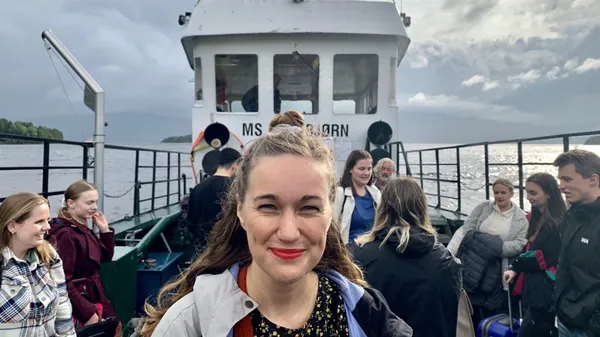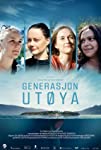Eye For Film >> Movies >> Generation Utøya (2021) Film Review
Generation Utøya
Reviewed by: Jane Fae

Generation Utøya is a compelling, fascinating, humbling insight into a massacre. Not, as such documentaries often are, from the outside, meticulously narrating the events leading up to, the details of the day, the motives, the aftermath, the “lessons learned”. Rather, this is a no-holds-barred, troubling, up-close-and-scary survivors’ tale.
For those not aware, too young, too disconnected from the news, or just too uninvolved to remember, Utøya has a very particular place in the annals of Norway’s otherwise idyllic politics. On 22 July, 2011 a young man – Anders Breivik – carried out, in quick succession, two terror attacks. The first, a car bomb targeting the executive government quarter of Norway, next to the office of then Prime Minister Jens Stoltenberg, killed eight people and injured at least 209.

The second - so much more horrific, personal - took place a couple of hours later on the island of Utøya where a summer camp for the AUF, the youth division of the ruling Norwegian Labour Party, was under way. During that attack Breivik, armed with automatic weapons, walked calmly from place to place, killing as he went: 69 young people died. A further 110 (at least) were injured.
Yet this is not the story of that day. Or of Breivik. Rather, it takes that day for granted and focuses on four young women – Kamzy Gunaratnam, Line Hoem, Ina Libak and Renate Tårnes – for each of whom, in differing ways, that day will forever define the rest of their lives. Ironically so, for despite their protests, the sincerely expressed desire to move on, they forever, now, “survivors”.
How can they not be? For whether in attempting to put that day behind them or to use it in political rhetoric, they were there, are still with us, as so many are not.
To begin, the film explores that day, how each survived, whether by hiding in a cave or in the loo, nervously texting parents in case they might never get the chance to do so again. There is insight here into the raw fear of those minutes, hours, when every second might have been their last. The small calculation by one as to whether it was riskier to swim for safety through waters known to be dangerous even to the strongest swimmers, or to lie low. The guilt and relief felt by another who, hit three times by bullets, yet urged her friends to abandon her and save themselves – and then was glad when they did not.
Moving on, the film becomes more uneven, focussing on two – Kamzy and Ina – who chose to pursue a career in politics. Ina became, for a while, leader of the AUF: Kamzy is Deputy Mayor of Oslo and, as the film shows, is now second on the local Labour candidates list, well placed to become a member of Norway’s parliament in 2021. Line and Renate fade a little here. Yet that day has left its mark on them, too.
These are not saints. They are good, thoughtful compassionate people who care about their country and the direction it is taking. They have confronted the truly difficult issues of today: social inclusion, and exclusion. The limits of free speech. The fact that actions do not come from nowhere, for as one remarks: “Language can be both lofty and vulgar.[…] Words can inspire hate. Words can inspire love”, and, in the end: “Freedom of expression can’t just be letting people say whatever they want”. Because consequences.
Against this, the rentaquote interview with a right-wing populist politician asserting that she will not be silenced is shown up for the hollow posturing it is. Fascinating, too, because it is not obviously what this documentary is about, is the insight into the political process. Ina and Kamzy writing speeches, weighing words, sitting on committees.
Did directors Sigve Endresen and Aslaug Holm intend – surely, they must – to show up the political establishment for the posse of self-seekers it appears to be? Surely, they did. For what comes across is the contrast between the still hopeful idealism of these young women and the cynicism of their elders: patronising, manipulating, using their pain and suffering for their own ends: politely welcoming them into committees. But carrying on as normal anyway.
There is a whiff here of values long forgotten. Because alongside the hope there is much talk of love… a motto inscribed on a piece of paper at the latest summer camp proudly proclaims “all you need is love”. Briefly discussing Breivik there is a reluctance to blame him outright: “When someone becomes a racist, we must ask: how did society fail”.
That is…amazing. Unexpected. “Typical woolly liberals!”, you hear the tabloids yell. At least they’d like to yell, but such cheap dismissal is hard to deploy against someone who has undergone what these people have.
Criticism? The documentary starts slow: much footage of Kamzy and Ina typing speeches, practising speeches. At times, it begins to take on the feel of a party political on behalf of the Norway Labour Party. It raises questions about speech and the rise of extremism that are then just left hanging. Perhaps it can do no more. Yet while this is a worthy direction it is also slightly frustrating.
Overall, it is well-meaning and, in the end, upbeat: because we end with hope, not despair. And yet…and yet…stepping back there is just a sense that that hope is the product of narrative trickery – let’s end on a positive note – rather than any real cause for hope.
I liked this. It is worth a watch.
Reviewed on: 05 May 2021

















